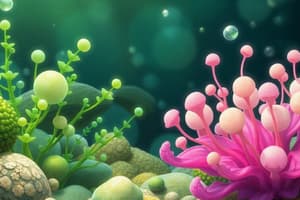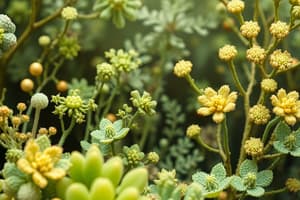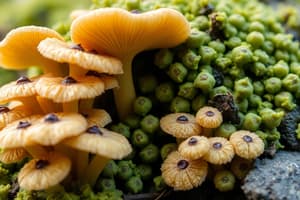Podcast
Questions and Answers
What is the main storage form of food in unicellular algae?
What is the main storage form of food in unicellular algae?
- Protein
- Oil droplets
- Starch (correct)
- Sugar
What are the whip-like structures associated with zoospores called?
What are the whip-like structures associated with zoospores called?
Flagella
Algae reproduce only through sexual reproduction.
Algae reproduce only through sexual reproduction.
False (B)
In isogamy, gametes are __________ in morphology.
In isogamy, gametes are __________ in morphology.
Match the following terms with their correct descriptions:
Match the following terms with their correct descriptions:
Which of the following best describes gymnosperms?
Which of the following best describes gymnosperms?
Angiosperms are characterized by having naked seeds.
Angiosperms are characterized by having naked seeds.
What is the primary reproductive structure of bryophytes?
What is the primary reproductive structure of bryophytes?
Gymnosperms typically have _____-shaped leaves.
Gymnosperms typically have _____-shaped leaves.
Which of the following statements about monocotyledons is correct?
Which of the following statements about monocotyledons is correct?
Match the following plant categories with their characteristics:
Match the following plant categories with their characteristics:
All seed-bearing plants are classified under angiosperms.
All seed-bearing plants are classified under angiosperms.
Name the male sex organ in bryophytes.
Name the male sex organ in bryophytes.
Which of the following plants reproduce asexually by fragmentation?
Which of the following plants reproduce asexually by fragmentation?
Mosses have true roots and vascular tissues.
Mosses have true roots and vascular tissues.
What is the name of the female sex organ in mosses?
What is the name of the female sex organ in mosses?
Moments of fragmentation in liverworts lead to the formation of ________.
Moments of fragmentation in liverworts lead to the formation of ________.
What type of reproduction occurs in mosses?
What type of reproduction occurs in mosses?
Asexual reproduction in plants requires two parents.
Asexual reproduction in plants requires two parents.
Name one environment where liverworts typically grow.
Name one environment where liverworts typically grow.
Match the type of asexual reproduction with its description:
Match the type of asexual reproduction with its description:
Which of the following types of algae is known for having a cell wall composed of cellulose and algin?
Which of the following types of algae is known for having a cell wall composed of cellulose and algin?
All fungi are unicellular organisms.
All fungi are unicellular organisms.
What is the primary reproductive method of bacteria?
What is the primary reproductive method of bacteria?
The cell wall of fungi is primarily composed of ______.
The cell wall of fungi is primarily composed of ______.
Match the following fungal phyla with their characteristics:
Match the following fungal phyla with their characteristics:
Which organism is known for having a cell wall of peptidoglycan?
Which organism is known for having a cell wall of peptidoglycan?
Fungi can reproduce both asexually and sexually.
Fungi can reproduce both asexually and sexually.
What are the unicellular microorganisms that are members of the fungi group called?
What are the unicellular microorganisms that are members of the fungi group called?
Which of the following is NOT a type of plant reproduction?
Which of the following is NOT a type of plant reproduction?
Angiosperms are defined as plants that produce seeds that are not protected.
Angiosperms are defined as plants that produce seeds that are not protected.
Name an example of a biennial plant.
Name an example of a biennial plant.
In sexual reproduction, male and female ______ are involved.
In sexual reproduction, male and female ______ are involved.
Match the following types of flowering plants with their characteristics:
Match the following types of flowering plants with their characteristics:
What is the primary function of the flower in a plant?
What is the primary function of the flower in a plant?
The carpel is a part of the flower involved in sexual reproduction.
The carpel is a part of the flower involved in sexual reproduction.
During sexual reproduction, the first stage is called ______.
During sexual reproduction, the first stage is called ______.
What is cross pollination?
What is cross pollination?
Self pollination occurs only between different plants.
Self pollination occurs only between different plants.
What is the primary role of the fruit in plant reproduction?
What is the primary role of the fruit in plant reproduction?
Insect pollination is known as ______.
Insect pollination is known as ______.
What characteristic is common among wind-pollinated flowers?
What characteristic is common among wind-pollinated flowers?
Dandelion seeds are dispersed through animal consumption.
Dandelion seeds are dispersed through animal consumption.
Match the following types of pollination with their descriptions:
Match the following types of pollination with their descriptions:
After fertilization, the zygote becomes the ______.
After fertilization, the zygote becomes the ______.
Flashcards
Algae
Algae
Simple aquatic organisms that can be unicellular, colonial, or multicellular.
Pyrenoids
Pyrenoids
Storage bodies in algae's chloroplasts that contain protein and starch.
Reproduction methods
Reproduction methods
Algae reproduce through vegetative, asexual, and sexual methods.
Isogamy
Isogamy
Signup and view all the flashcards
Chlorophyll in algae
Chlorophyll in algae
Signup and view all the flashcards
Phyla of Algae
Phyla of Algae
Signup and view all the flashcards
Fungi
Fungi
Signup and view all the flashcards
Chitin
Chitin
Signup and view all the flashcards
Reproduction in Fungi
Reproduction in Fungi
Signup and view all the flashcards
Binary Fission
Binary Fission
Signup and view all the flashcards
Bacterium
Bacterium
Signup and view all the flashcards
Pili
Pili
Signup and view all the flashcards
Soredia
Soredia
Signup and view all the flashcards
Gymnosperms
Gymnosperms
Signup and view all the flashcards
Angiosperms
Angiosperms
Signup and view all the flashcards
Monocotyledons
Monocotyledons
Signup and view all the flashcards
Dicotyledons
Dicotyledons
Signup and view all the flashcards
Bryophytes
Bryophytes
Signup and view all the flashcards
Gametophyte
Gametophyte
Signup and view all the flashcards
Antheridium
Antheridium
Signup and view all the flashcards
Sexual Reproduction
Sexual Reproduction
Signup and view all the flashcards
Annuals
Annuals
Signup and view all the flashcards
Biennials
Biennials
Signup and view all the flashcards
Perennials
Perennials
Signup and view all the flashcards
Monocarpic
Monocarpic
Signup and view all the flashcards
Flower Parts
Flower Parts
Signup and view all the flashcards
Pollination
Pollination
Signup and view all the flashcards
Archegonium
Archegonium
Signup and view all the flashcards
Characteristics of Moss
Characteristics of Moss
Signup and view all the flashcards
Moss Reproduction
Moss Reproduction
Signup and view all the flashcards
Liverworts
Liverworts
Signup and view all the flashcards
Gemmae
Gemmae
Signup and view all the flashcards
Plant Reproduction
Plant Reproduction
Signup and view all the flashcards
Types of Asexual Reproduction
Types of Asexual Reproduction
Signup and view all the flashcards
Self-pollination
Self-pollination
Signup and view all the flashcards
Cross-pollination
Cross-pollination
Signup and view all the flashcards
Insect Pollination
Insect Pollination
Signup and view all the flashcards
Wind Pollination
Wind Pollination
Signup and view all the flashcards
Fertilization
Fertilization
Signup and view all the flashcards
Seed Dispersal
Seed Dispersal
Signup and view all the flashcards
Animal Dispersal
Animal Dispersal
Signup and view all the flashcards
Study Notes
Plant Classification
- The most common method for classifying plants is based on their descent or phylogenetic relationships.
- Phylogenetic classification systems are based on evolutionary relationships between various organisms.
- This assumes that organisms belonging to the same taxa share a common ancestor.
- Approximately 3,000,000 plant species are identified and classified into four main divisions: Thallophytes, Bryophytes, Pteridophytes, and Spermatophytes.
Thallophytes
- Thallo = plant body without roots, stems, or leaves
- Phyta = a plant
- Thallophytes include Algae, Fungi, Bacteria and Lichens.
- Thallophytes are primarily aquatic organisms.
- Thallophytes are unicellular, colonial or multicellular.
- Thallophytes reproduce mainly asexually.
- Thallophytes are also termed Cryptogamae.
Algae
- Algae are pond scums, fresh and marine phytoplanktons.
- Algae are relatively undifferentiated and lack true roots and leaves.
- The "green algae is the most diverse group of algae."
- There are over 7000 species found in many habitats.
- Algae contain the green pigment chlorophyll that uses sunlight energy to produce food through photosynthesis.
- Algae can be unicellular, colonial or multicellular.
- Algae reproduce asexually through fragmentation or by producing zoospores.
- Algae reproduce sexually through isogamy.
- Algae have different cell walls(e.g Cellulose, algin, cellulose, agar, pectin, silica).
- Different types of algae occupy different depths in water.
Fungi
- Fungi are eukaryotic organisms that can be unicellular or in multicellular form (mushrooms).
- Fungi are heterotrophs.
- Fungi have cell walls made of chitin.
- Fungi reproduce asexually through fragmentation, budding, or spores.
- Fungi reproduce sexually by producing spores in fruiting bodies like mushrooms.
- Fungi cause plant diseases including rusts, smuts, and leaf, root, and stem rots.
Lichens
- A lichen is a composite organism that develops from algae or cyanobacteria and fungus.
- Lichens come in different colours, sizes and shapes, but they are not plants.
- Lichens produce their own food by photosynthesis
- Lichens do not grow as parasites on plants, but use plants as substrate for growth.
- Lichens reproduce asexually by soredia.
Bryophytes
- Bryophytes include mosses and liverworts.
- Bryophytes are also known as the 'amphibians of the plant kingdom' and are found typically in moist, shaded areas in the hills.
- They have no vascular system.
- They need water for sexual reproduction.
Mosses
- Mosses are the simplest plants.
- Mosses do not have roots, vascular tissues (no transport), simple stems and leaves, but they have rhizoids for anchorage.
- Mosses reproduce by producing spores in capsules.
- Mosses reproduce asexually by fragmentation or budding in secondary protonema
Liverworts
- Liverworts are found in moist, shady habitats.
- Liverworts reproduce asexually by fragmentation, or by gemmae formation.
Spermatophytes
- Spermatophytes encompass all seed-bearing plants divided into Gymnosperms and Angiosperms.
Gymnosperms
- These are naked seed plants.
- They include trees with needle-shaped leaves and cones that have naked seeds located in the female cones.
- They do not produce fruit because they lack ovaries.
Angiosperms
- These produce seeds in an enclosed structure, a fruit.
- They include trees, herbs, shrubs, water plants, and grasses.
- Two types of angiosperms are Monocots (one cotyledon) and Dicots (two cotyledons).
Plant Reproduction
- Plants reproduce asexually or sexually.
- Asexual reproduction happens when no gametes are required and only one parent is needed.
- Sexual reproduction requires two parents and involves gametes(male and female gametes)
- Types of asexual reproduction include fission, budding, fragmentation, and spore formation.
- Types of sexual reproduction include stages like pollination, fertilization, seed formation, seed dispersal and germination.
- There are three types of flowering plant life cycles: annuals, biennials, and perennials.
- Annuals complete their life cycle in one year.
- Biennials complete their life cycle in two years.
- Perennials live for several years.
Classification of Plant Reproduction
- Monocarpic plants: are those that flower, set seeds and die.
- Plant reproduction can be classified by the time the plant species take to complete life cycle and flowering such as annuals, biennials and perennials.
- Parts of a complete flower: sepals, petals, carpel, stamen
Seed Dispersal
- Dispersal of seeds is carried by wind, animals, water, and plant bursting.
- Examples: wind (dandelion, maple), animals (edible fruits, hooked fruits), water (water lilies), and bursting seed pods (some plants).
Studying That Suits You
Use AI to generate personalized quizzes and flashcards to suit your learning preferences.




